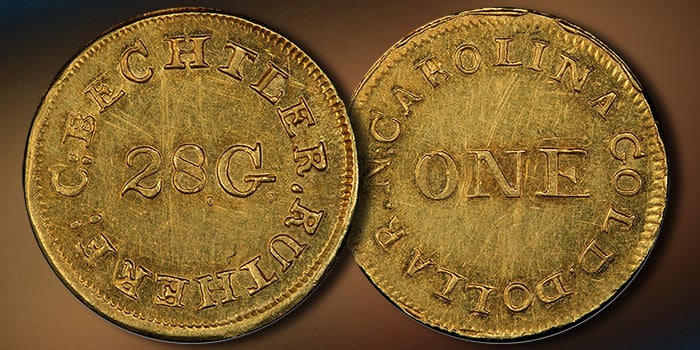
By Victor Bozarth for PCGS ……
In parts one and two of my four-part series, I detailed the early European explorers who failed in their search for gold in the future United States. In part two, I discussed the discovery of gold in North Carolina in 1799. Also discussed was the evolution of mining, from farmers digging for gold nuggets in their fields after harvest to professional miners immigrating in the 1820s to perform lode shaft mining.
In part three, I will discuss the early Dahlonega gold strikes, the administration of President Andrew Jackson, and the Indian Removal Act. That the Charlotte, Dahlonega, and New Orleans Mints were built in 1838 to some extent was predictable. The gold was there and the demand was clear – as evidenced by the success of the Bechtler Mint that operated from 1831 through 1850.
The Bait-and-Switch Land Grab
Encroachment on Native American lands was gradual. These territories in the Southeast were guaranteed to the Five Tribes by treaties originating during and just after the Revolutionary War. Early encroachment on Native American land probably wouldn’t have involved gold; cotton growers and smaller farmers wanted the land. Move a fence over, graze your livestock on Native pasture, shoot a buck or two in their mountains…
Neighbors are neighbors, but the Native Americans had virtually no way of protecting their property. A little-known fact is that private citizens could not purchase land directly from Native Americans. But when gold was found in the Gold Belt, encroachment was inevitable. Perhaps the thinking was, “If we can’t buy it, we’ll just take it.”
Andrew Jackson could certainly be described as a “man of his times.” Our seventh president was also a product of his environment. It seems one either liked him or hated him – as did Davy Crockett. Many described Jackson as a mean and unpleasant man.
Some might also point to the positive aspects of Jackson’s life. Sure, his face is on the $20 bill. But he was also a major general in the War of 1812, a congressman, and senator before being elected president in 1828. Jackson always felt he should have been the sixth president after winning the electoral college vote in 1824. When the vote went to House Speaker Henry Clay, he threw his support behind John Quincy Adams. Jackson believed the “popular will of the people” had been “thwarted by intrigue.”
Examining Jackson’s life from childhood through his election as president sheds much light on the man himself. Jackson’s father was killed three weeks prior to his birth. His mother and both younger brothers died while being held prisoner by the British during the Revolutionary War. Jackson’s facial scar resulted from a blow by a British Army officer whose boots Jackson had refused to shine during this imprisonment.
Not only did Jackson despise the British, but the British had allied themselves with both the Creek peoples in the Revolutionary War and the Seminole peoples in the War of 1812. The Creek and Seminole were two of the Five Tribes, a group that also included the Cherokee, the Choctaw, and the Chickasaw. Jackson apparently had little sympathy for the plight of the Five Tribes.
When Jackson took office in 1829, the fresh gold finds in Dahlonega only increased pressure from both private and government forces against the Five Tribes. Regardless, in the “nation-building” rush of that era, Jackson was more than willing to lead the charge.
The “bait-and-switch” aspect of the Indian Removal Act was two-fold. Not only did the government want the Native American land guaranteed to them by prior treaty, but it also wanted these Native Americans gone – removed. There’s no way to candy coat it. The entire act and its enforcement was despicable.
The Indian Removal Act was signed into law on May 28, 1830. There were two parts to the Act. The first, the BAIT, was the authorization by the president to grant lands west of the Mississippi River in exchange for, the SWITCH, Native American lands within existing state borders (REMOVAL). The Act authorized the president to “negotiate” with southern Native Americans for their removal to federal territory west of the Mississippi River in exchange for “their Ancestral Lands.” Little negotiation was done.
From 1831 to 1838, the Five Tribes were herded west in five different major forced migrations culminating in the Trail of Tears. In 1838, General Winfield Scott rounded up the last of the roughly 15,000 Cherokee peoples remaining in Georgia and forced them to move west, mostly on foot. More than 25% of those forced into this final migration, the actual Trail of Tears, died. Interestingly, while Jackson was responsible for the Indian Removal Act itself, the Martin Van Buren administration was left to enforce it.
Meeting a Need for Coinage
There was an acute and ongoing need for assay and coining services in the Gold Belt, but that need remained unfilled until Templeton Reid opened the first private minting operation in 1830. Reid, a skilled gunsmith and jeweler, made coins in both Milledgeville and Gainesville, Georgia, starting in July 1830. His efforts were short-lived because of irregular assays resulting in light coins. Reid minted roughly 1,600 coins before he ended operations in October a few months later. Reid later made two 1849-dated issues, which are extremely rare.
The Bechtler Mint in North Carolina was a different story. Originally the Bechtler family moved from Philadelphia to North Carolina in 1830. They set up a small watch- and jewelry-making business north of Rutherfordton. Miners immediately began to request that the Bechtlers assay and stamp their gold. Father Christopher Bechtler and sons Augustus and Charles, as well as nephew Christopher, Jr., had all moved from Philly. Christopher, Sr. soon set up a private assay and coining business.
From 1831 to 1850 the Bechtler family produced gold coins in Rutherford County, North Carolina. The demand for coinage was acute. Bechtler’s services were both needed and most importantly trusted. For two decades the family’s services were in demand. Between 1831 and 1846, the Bechtlers coined over $2 million in quarter eagle and half eagle gold coins.
In 1840, Christian, Sr. gave the business to his son Augustus. The mint itself moved to Rutherfordton and Augustus made large quantities of gold dollars until his death in 1846. Christopher, Jr. inherited the business from Augustus and continued to make coins until 1850 when the United States Mint started producing gold dollars in quantity.
The Bechtlers made coins in three denominations: $1, $2.50, and $5 gold coins. They used three different inscriptions: NORTH CAROLINA GOLD, CAROLINA GOLD, and GEORGIA GOLD. These location stamps indicated the fineness of the particular issue. Once the mints in Charlotte and Dahlonega opened in 1838, the Bechtlers’ business declined and there was more focus on producing gold dollars.
On only some of the $5 coins does a date appear. August 1, 1834, is seen on some of the half eagles. All the Bechtler products used only numbers for the denomination and date, and letters for the legend that showed the location, and the Bechtler name. There are no other design motifs.
Once the U.S. Mint began making gold dollars in quantity in 1849, the demand for services from the Bechtlers was gone. With the new mints in operation, bullion went there for coining.
Through a law signed on March 3, 1835, the Charlotte, Dahlonega, and New Orleans Mints were established. The Act provided for the production of gold and silver coins at New Orleans, but only gold coins were authorized at both the Charlotte and Dahlonega Mints.
Construction of the Charlotte Mint did not begin until 1836, and the facility opened for production on July 27, 1837. Over $5 million worth of coins were minted at Charlotte before North Carolina seceded from the union. The total mintages by denomination are as follows:
- Gold dollars: 109,134 mintage; $109,134 face value
- Quarter eagles: 217,833 mintage; $544,583 face value
- Half eagles: 879,571 mintage; $4,397,855 face value
- Total face value: $5,051,572
Construction of the Dahlonega Mint began sometime after August 1835 and Ignatius Alphonso Few, the appointed commissioner, hired the architect Benjamin Towns to construct the Mint within 18 months. Superintendent Dr. Joseph Singleton opened the Mint in February 1838. Within the first week, 1,000 ounces of gold had been deposited. The first coins were 80 half eagles minted on April 17, 1838.
The Dahlonega Mint produced coins from 1838 to 1861 in denominations of $1, $2.50, $3, and $5. Because the Confederate States of America (CSA) took over in 1861, the exact total of coins minted in Dahlonega is unknown but the estimate is roughly $6 million face value. Both 1861-D Gold Dollars and 1861-D Half Eagles were struck by the CSA. While the mintage of the gold dollar is unknown, 1,597 half eagles were struck.
The 10 years from Andrew Jackson’s election to the presidency were marked with tremendous national growth. Between 1828 and 1839, two more states, Arkansas and Michigan, had been added to the Union. A large percentage of the country east of the Mississippi River was considered settled, arguably because the Native Americans had been removed. In 1836, the first wagon train left Independence, Missouri (Kansas City) on the Oregon Trail and western expansion really took off.
I will conclude my series in the next article. I’ll discuss the continued expansion to the West as our country grew, but I also want to delve into the scarcer, rarer Charlotte and Dahlonega gold coin issues. Political and financial events prior to the Civil War will be reviewed. My series will end with the “first shots fired” at Fort Sumter, South Carolina, and the coins produced by the CSA at both the Charlotte and Dahlonega Mints.
* * *






Very informative